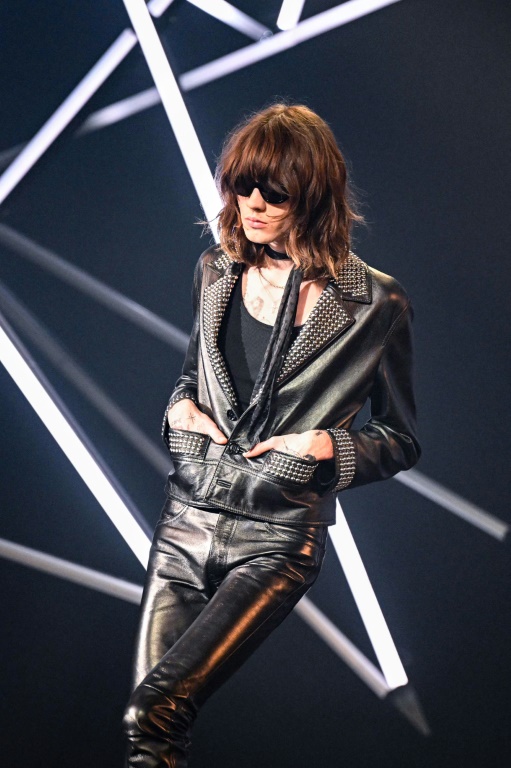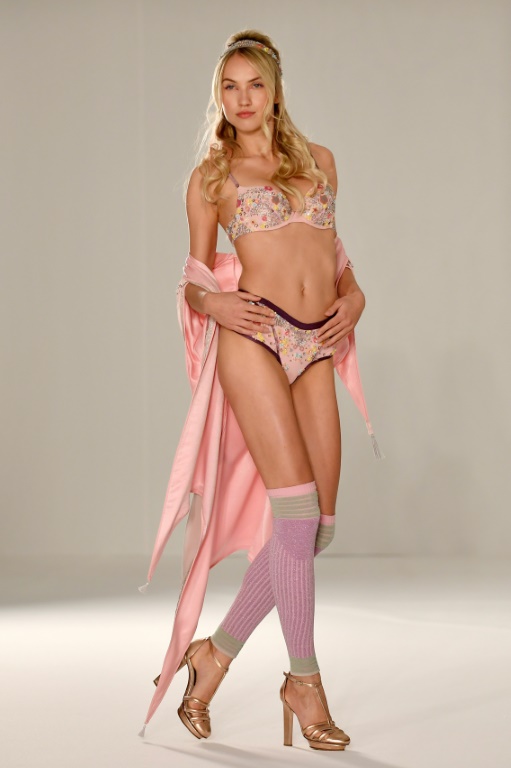Saint Laurent fashion show in Paris, March 1, 2022 (AFP/Archives/JULIEN DE ROSA)
“It’s fashion, darling, you just have to lose weight”: despite the appearance of curvy models on the catwalks, the injunction to be thin remains omnipresent in the fashion sector, where clothes are designed for ultra-thin bodies.
The buxom models, which we see more in New York and London, but also sparsely in Paris, aim to “show that the brand is inclusive”, but “in fact it is about preserving a system based on the tyranny of the thin ideal,” Paolo Volonté, who teaches fashion sociology in Milan (Italy), told AFP.

Ester Manas fashion show in Paris, March 4, 2023 (AFP/Archives/Geoffroy Van der Hasselt)
The failure in terms of diversity of body types is total, according to data collected by Vogue Business during the previous season of ready-to-wear weeks.
Of 9,137 outfits unveiled during 219 fashion shows in New York, London, Milan and Paris, 95.6% were presented by slim models (sizes 32-36). Only 0.6% concerned plus size models (44 and over) and 3.8% of models with a size between 38 and 42.
The brands “refuse to represent normal people”, summarizes Ekaterina Ozhiganova, 31 years old, model, law student and founder of the “Model Law” association which defends the rights of models.
– Difficult to verbalize –
Having size M, the most common in everyday life, is an aberration in fashion: “we will suggest that they either lose weight to return to the +real+ size, or switch to XL. Neither one nor the other is healthy,” she adds to AFP.

Ashi haute couture show in Paris, July 6, 2023 (AFP/Archives/Geoffroy VAN DER HASSELT)
Requested by the delegation of women’s rights to the French Senate in April, she sounded the alarm about the risks to the health of models, forced to lose weight or gain weight on demand.
Nine out of ten models responded that they felt pressure to change their appearance “regularly” (52.5%) or “occasionally” (37.7%), according to a new survey conducted before these auditions.
“It’s very difficult to verbalize. You can complain on the internet and everyone will answer you ‘Honey, that’s the job'”, says Ekaterina Ozhiganova.
However, texts were adopted in 2017 introducing a compulsory medical certificate for models, while the luxury giants LVMH and Kering signed the same year the charter committing to removing size 32 from their casting requests. Measures little effect.
– “Erasing gender” –

Celine fashion show, February 10, 2023 (AFP/Archives/Emmanuel DUNAND)
The ban on 32 doesn’t mean much, reacts Ekaterina Ozhiganova, because sizes vary depending on the house and clothes in 34 can run small…
The standards of male beauty have also changed. Hermès thus produces clothes in size 48 for the fashion shows, recently told Véronique Nichanian, stylist of the men’s collections for 35 years. “When I started in fashion, the model size was 52 (…) The sexy standard at the time was the muscular beach boy!”, she stressed to the daily Libération.
It is the aesthetic of “gender erasure” that makes creators “want a similar kind of body”, analyzes Ekaterina Ozhiganova.
For Paolo Volonté, it is easier to produce on an industrial scale for thin and flat bodies.

Czech model Michaela Tomanova parade for Julien FOurnié haute couture, January 24, 2023 (AFP/JULIEN DE ROSA)
“The size-scoring technique means you start at size zero and work your way up using an algorithm. But it doesn’t work for larger sizes because fat and muscle don’t obey the algorithm, he emphasizes. “It’s much more expensive to produce and sell clothing in larger sizes, it requires a lot more know-how.”
“From an industrial point of view, we cannot produce a large size dress,” confirms Saudi designer Mohammed Ashi to AFP, rejecting any “discrimination”.
And haute couture with its principle of tailor-made is doing better, underlines French couturier Julien Fournié who, for example, has paraded pregnant women. Her favorite model Michaela Tomanova has a woman’s body and “six centimeters everywhere more than the others”.
But “fashion remains fashion”, “it’s a fantasy world” and “that will never change fundamentally”, he concludes.
© 2023 AFP
Did you like this article ? Share it with your friends using the buttons below.




